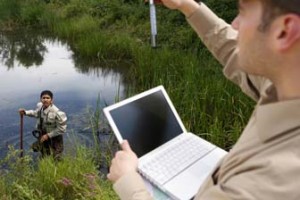Environmental Protection Jobs
Environmental restoration planners oversee the implementation of restoration projects and developing of new products
Environmental restoration planners oversee the implementation of restoration projects and developing of new products
Environmental restoration planners evaluate the conditions of the ecosystems to determine the extent of impacts caused by climate change, pollution, human activity, and nature. Environmental restoration planners use the results of their studies of these areas to determine the need for environmental remediation and conservation efforts. They incorporate data from ecosystems and geographical imaging system data to create restoration plans.
Environmental restoration planners perform duties such as collecting and analyzing data to determine environmental conditions and restoration needs. They develop and communicate recommendations for landowners to maintain or restore environmental conditions. They work on restoration solutions to solve environmental problems such as the Gulf of Mexico dead zone. Environmental restoration planners also plan environmental restoration projects, using biological databases, environmental strategies, and planning software. They communicate findings of environmental studies or proposals for environmental remediation to other restoration professionals.
 Environmental restoration planners often need to conduct site assessments to certify a habitat or to ascertain environmental damage or restoration needs. They then develop environmental restoration project schedules and budgets. Environmental restoration planners also create habitat management or restoration plans, such as native tree restoration and weed control. They supervise and provide technical guidance, training, or assistance to employees working in the field to restore habitats. Environmental restoration planners conduct feasibility and cost-benefit studies for environmental remediation projects. They then apply for permits required for the implementation of environmental remediation projects.
Environmental restoration planners often need to conduct site assessments to certify a habitat or to ascertain environmental damage or restoration needs. They then develop environmental restoration project schedules and budgets. Environmental restoration planners also create habitat management or restoration plans, such as native tree restoration and weed control. They supervise and provide technical guidance, training, or assistance to employees working in the field to restore habitats. Environmental restoration planners conduct feasibility and cost-benefit studies for environmental remediation projects. They then apply for permits required for the implementation of environmental remediation projects.
Environmental restoration planners identify short and long term impacts of environmental remediation activities. They also conduct environmental impact studies to examine the ecological effects of pollutants, disease, human activities, nature, and climate change. Environmental restoration planners review existing environmental remediation designs. They then provide technical direction on environmental planning to energy engineers, biologists, geologists, or other professionals working to develop restoration plans or strategies.
As part of their job, environmental restoration planners develop natural resource management plans, using knowledge of environmental planning or state and federal environmental regulatory requirements. They identify environmental mitigation alternatives, ensuring compliance with applicable standards, laws, or regulations. Environmental restoration planners inspect active remediation sites to ensure compliance with environmental or safety policies, standards, or regulations. They notify regulatory or permitting agencies of deviations from implemented remediation plans.
Environmental restoration planners also develop environmental management or restoration plans for sites with power transmission lines, natural gas pipelines, fuel refineries, geothermal plants, wind farms, or solar farms. They plan or supervise environmental studies to achieve compliance with environmental regulations in construction, modification, operation, acquisition, or divestiture of facilities such as power plants.
To perform their job, environmental restoration planners use a variety of tools and technologies. They create diagrams to communicate environmental remediation planning using geographic information systems (GIS), computer-aided design (CAD), or other mapping or diagramming software. They also create environmental models or simulations, using geographic information system (GIS) data and knowledge of particular ecosystems or ecological regions. To perform their analyses, they use analytical or scientific software such as HEC-RAS or IWR-PLAN. For map creation, they use map creation software such as ESRI ArcGIS software or ESRI ArcMap.
Environmental restoration planners work in both offices and laboratories. Some may spend time in the field gathering data and monitoring environmental conditions. Environmental restoration planners who work in the fields may have to work in all types of weather. Environmental restoration planners may have to travel to meet with clients or present recommendations to clients.
For most entry-level jobs, environmental restoration planners must have a bachelor’s degree in life sciences, environmental science or a science-related field, such as biology, chemistry, physics, geosciences, or engineering. A master’s degree may be needed for advancement. Students who study to become environmental restoration planners should look for opportunities, such as classes and internships, that allow them to work with computer modeling, data analysis, and geographic information systems. Students with experience in these programs will be the best prepared to enter the green job market as environmental restoration planners.
The Bureau of Labor Statistics (BLS) indicates a bright outlook for environmental restoration planners and expects employment of this field to growth between 15% and 21% from 2012 until 2022, faster than the average for all green jobs. The BLS projected 39,700 environmental restoration planner job openings between 2012 and 2022, and noted 90,000 jobs are currently filled. Titles include Coastal and Estuary Specialist; Director, Forest Restoration Institute; Director, River Restoration; Executive Director; Fish and Wildlife Biologist, Endangered Species Conservation and Recovery; Fisheries Habitat Restoration Specialist; Marine Habitat Resource Specialist; Program Manager, Environmental Planning; Project Manager; and Watershed Coordinator. The BLS further reports that the median annual wage for salaried environmental restoration planners was $65,090 in 2012 with median hourly wage of $31.29. Across the US job market, the lowest 10 percent earned less than $38,570, and the top 10 percent earned more than $109,970. Environmental restoration planners can receive the best compensation in District of Columbia, where they earn compensation, on average, of about $104880. People in this job function are compensated at the highest average salary in Utilities, where they get average pay levels of $81,540.